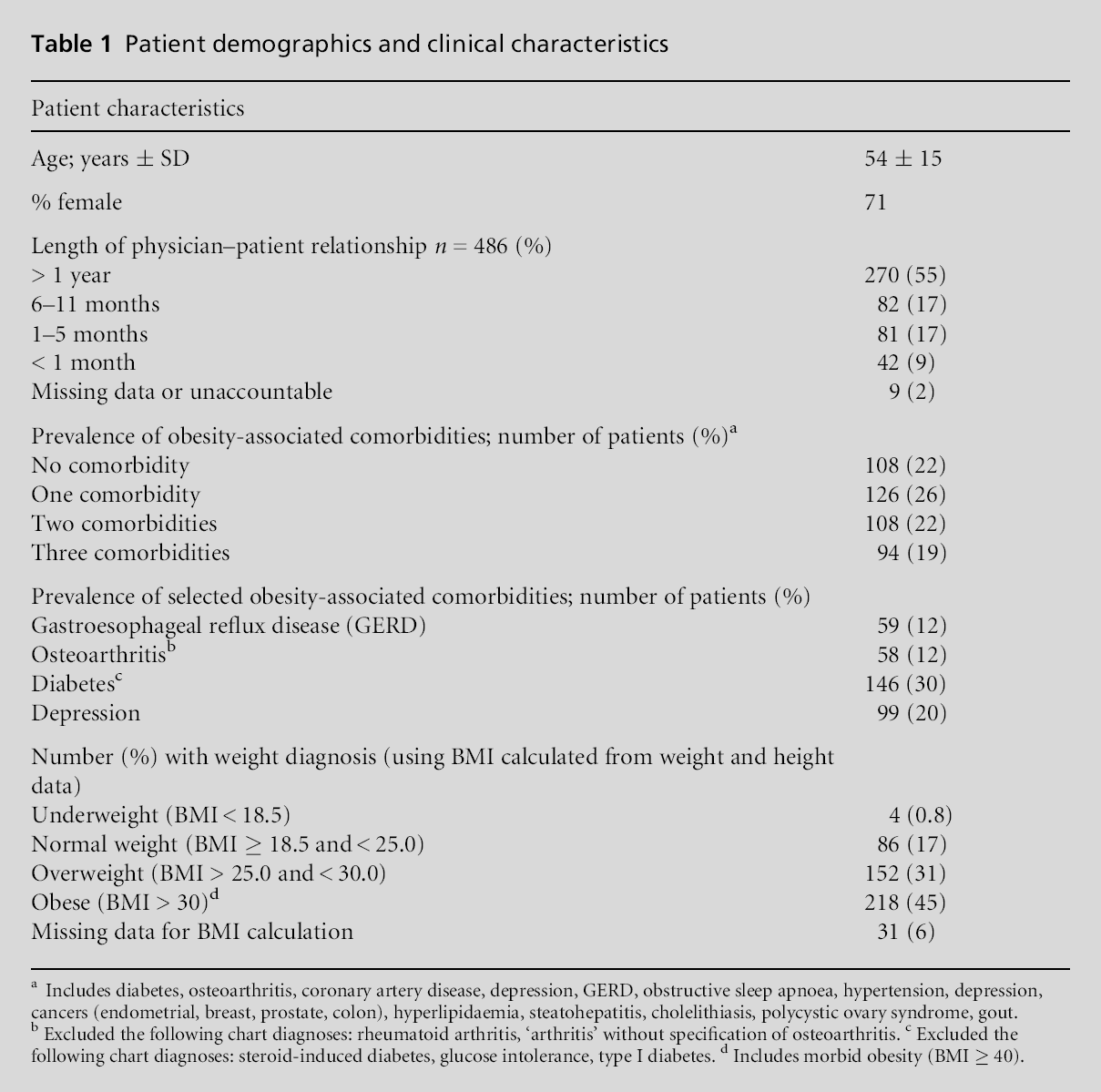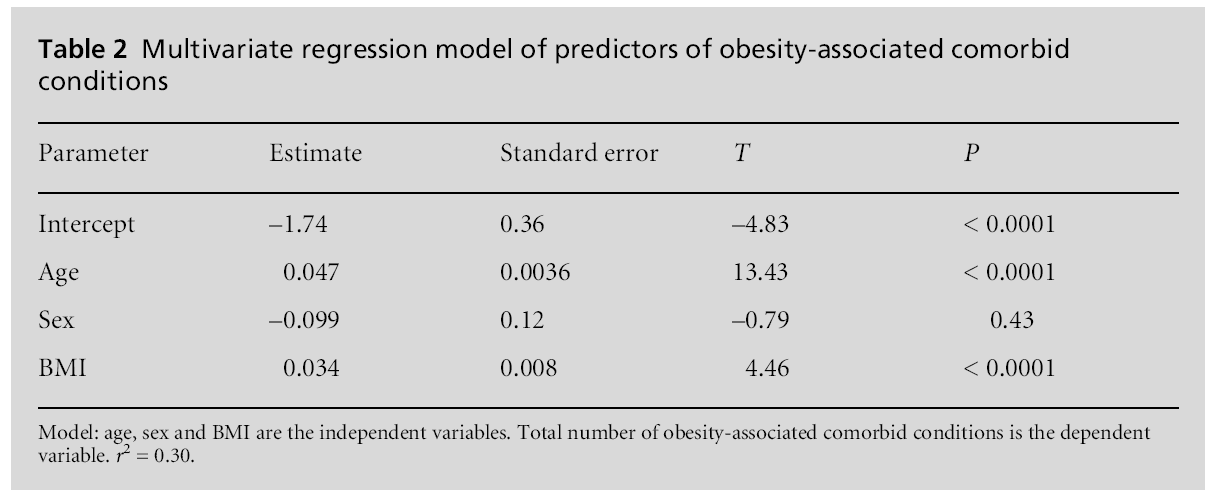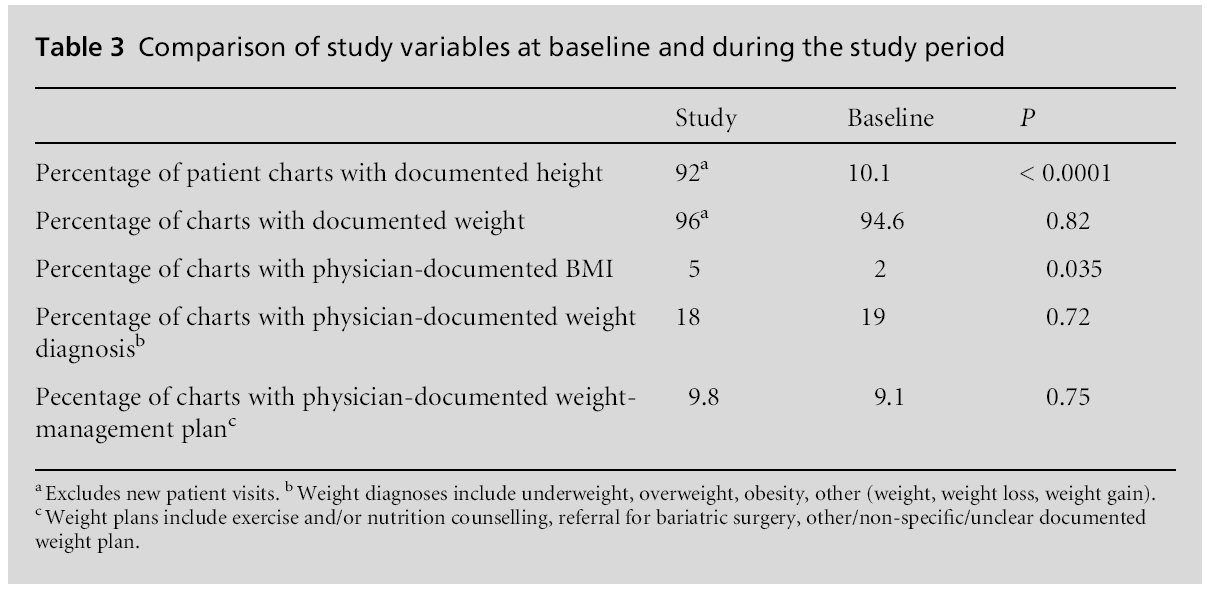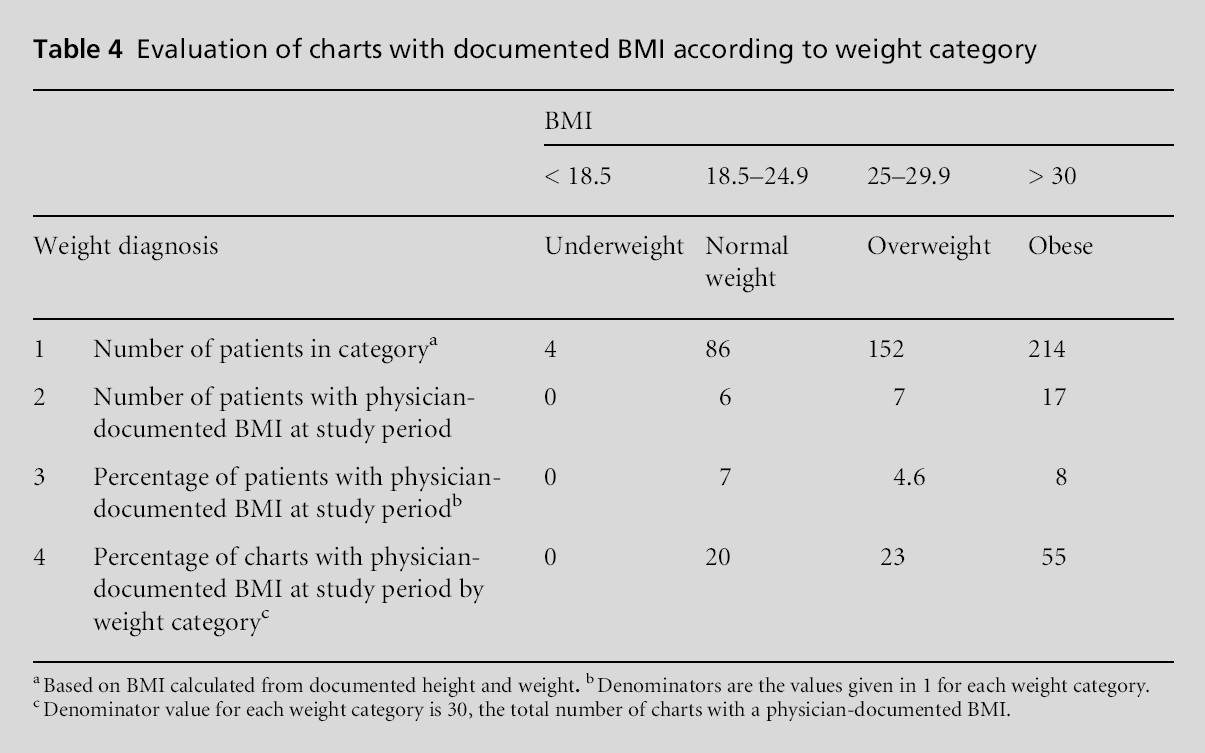Research Paper - (2013) Volume 21, Issue 4
University of Maryland School of Medicine, Division of Gerontology and Geriatric Medicine, Baltimore, USA
Galit Sacajiu MD MPH
ARC of Rockland Health Resources
Hillary Kunins MD MPH MS
Joseph Deluca MD
Montefiore Medical Center, New York, USA
Received date: 11 January 2013; Accepted date: 29 May 2013
BackgroundObesity and overweight diagnoses and treatment in primary care are very low despite the high prevalence of obesity. Insufficient data exist on whether a body mass index (BMI) chart reminder improves the diagnosis and management of obesity and overweight in primary care. MethodsWe designed and placed a BMI reminder stamp on progress notes from routine medical visits. We assessed the difference between baseline and study periods in the proportion of visits with documented: (1) BMI, (2) weight diagnoses, and (3) weight-management plan. ResultsObesity and overweight prevalence were 45 and 31%, respectively. Physicians documentedBMI in 3% (10/383) of visits at baseline compared with 5% (20/383) during the study period (P = 0.04). There was no difference in the frequency of weight diagnoses between the study periods (18 vs 19%; P = 0.7). The rate of documentation of weight- anagement strategies was 9% (vs. 10% at baseline, P = 0.75). ConclusionsWe observed a statistically significant association between the BMI chart reminder and physician documentation of BMI, but found no association between the BMI chart reminder and documentation of weight diagnoses or management. Research is needed to determine the usefulness of these reminders or of more intensive, yet practical, interventions in promoting physician recognition and management of overweight and obesity.
diagnosis, management, obesity, primary care, quality improvement
How this fits in with quality in primary care
What do we know?
Primary care physicians encounter many overweight and obese patients in primary care and manage numerous obesity-associated disease comorbidities. Yet, the frequency of diagnosis and management of overweight and obesity by primary care physicians are very low. Physician documentation of body mass index (BMI) has been found to be associated with increased documentation of weight diagnoses and management plans. Very few studies have evaluated the impact of BMI chart reminders on physiciandocumented weight diagnoses and management.
What this study adds
The observed low prevalence of overweight and obesity diagnoses in primary care is not caused by the availability (or absence) of height and weight data or to the availability of a chart reminder system. Visual diagnosis of abnormal weight may still be over-ruling objective diagnosis with BMI among physicians, even in the presence of a chart reminder system.We observed a relatively high rate of physician-documented BMI for patients with normal weight and obesity in this patient population with a high prevalence of obesity. The potential implication of such a finding may indicate missed diagnoses and counselling of individuals when they are overweight.
Overweight and obesity are associated with increased risk for the development of many chronic diseases treated in primary care settings, including diabetes, hypertension, osteoarthritis, hyperlipidaemia and coronary artery disease.[1] BMI, calculated as weight in kilograms divided by height squared in metres, is an index that assesses weight status by adjusting the patient’s weight for his/her height. The US Preventive Services Task Force (USPSTF) recommends using the BMI to detect patients who are overweight or obese.[2] However, obesity remains under-diagnosed and undertreated in primary care.[3–6] Often obesity is addressed in the context of its disease comorbidities, but such an approach leads to delayed weight management.[3,7–10] Furthermore, data suggest that patients expect physicians to counsel them about their abnormal weight status, yet physicians do not regularly do so.[11–15] Among other reasons, under-management of obesity in the primary care setting is attributed to inadequate use of BMI data to diagnose abnormal weight.[7,16] Physicians do not identify individuals at risk of obesity because they depend more on visual estimation[16] than on BMI to identify overweight and obese individuals. Increased recognition and diagnosis of obesity leads to increased weight management.[5,7,9,17] The purpose of this retrospective, intervention study was to investigate the impact of the availability of height and weight data, in the form ofBMI chart reminders, on physician documentation of BMI and documentation of abnormal weight diagnosis and management.
Setting
This research was conducted at a federally qualified community health centre located in the South Bronx, a predominantly Hispanic and economically disadvantaged neighbourhood. The health centre is home to internal medicine, paediatric, gynaecology, psychiatry, ophthalmology and dental practices. Thirty residents and 14 attending internists provide primary care in the internal medicine practice.
Intervention
The research intervention was a BMI chart reminder (Figure 1), which contained sections for weight, height and BMI. The reminder was stamped on all progress notes beginning on 1 July 2009. Following measurement of patients’ height and weight at each visit, nursing staff completed height and weight sections of the BMI stamp. The BMI section was left blank to prompt physicians to calculate and record BMI. To acclimatise the providers to the location of BMI charts, coloured BMI charts were placed in conspicuous places in all examination rooms a few months before the implementation of the BMI chart reminders.[18] These coloured BMI charts replaced the black and white BMI charts in these rooms. All physicians, except for authors GS, IM and JD, were blinded to the study purpose.
Measures and outcomes
BMI and weight diagnoses were determined from nurse-recorded height and weight data whether or not the primary care physician-documented BMI, weight diagnosis and weight plan in the chart. Obesity was defined as a BMI 30 kg/m 2 and morbid obesity defined as a BMI of > 40 kg/m2. Individuals with a BMI between 25 and 29.9 kg/m2 were classified as overweight, whereas those with a BMI between 18.5 and 24.9 kg/m2 were classified as normal weight. Underweight was defined as a BMI < 18.5 kg/m2. Physician recognition of weight status was evaluated by determining whether or not the physician documented: BMI either in the chart reminder stamp, in the progress note or in the problem list; weight diagnoses in the problem list or in the progress note; and a weight-management plan.
The primary outcomes were the difference between the baseline and study periods in the proportion of visits with physician-documented BMI and weight diagnoses. The secondary outcome was the difference before and during the intervention in the frequency of physician-documented weight-management plans.
Statistical analysis
Sample size was calculated using a P-value of 0.05 and a power of 80% to determine number of charts needed to detect changes for each of the pre and post variables: (1) BMI documentation frequency, (2) weight diagnosis documentation frequency, and (3) weight management.
The study hypotheses were as follows:
. BMI chart reminders would increase physician documentation of BMI from an estimated baseline of 2% to 15% post intervention.
. The use of BMI chart reminders would increase diagnosis of overweight from 3 to 10% and of obesity from 20 to 35%.
. Increased BMI documentation would be associated with an increase in the frequency of charts with documented weight management from 15 to 25% among the obese group and from 2 to 7% for the overweight group.
Results from published studies provided a guide for the estimated percentages in the study hypotheses.[7,10] Sample sizes required to observe significant results for all three hypotheses ranged from155 to 500. Thus, the largest estimated sample size of 500 was selected for this study. Data analysis was done mostly with SPSS version 17 Statistical software. Only the multivariate regression analysis was performed with SAS Enterprise Guide version 4.2. McNemar’s test was used to compare paired proportions.
Data extraction
Charts were screened fromelectronic records to select only those from follow-up visits that occurred during the intervention period. These charts were numbered serially. A random number generator (www.random.org) generated random numbers which were used to identify numbered charts. These randomly selected charts were used for this analysis to extract both the pre- and post-intervention data.
All data were extracted from the medical record using a structured chart review instrument. Data were extracted from the patient’s problem list and from written progress notes, which had been scanned into the electronic medical record. Demographic variables extracted included the patient’s age and gender. Obesityassociated comorbidities extracted included diabetes, hyperlipidaemia, coronary artery disease, obstructive sleep apnoea, steatohepatitis, gastro-oesophageal reflux disease (GERD). Weight diagnoses extracted from the chart included: underweight, overweight, obesity, morbid obesity, weight gain, weight loss, other (e.g. ‘weight’). These weight diagnoses were extracted as documented by the providers in the patients’ charts. Weight-management plans were classified under nutrition, physical activity, referral for bariatric surgery.
Pre and post data were extracted from charts of routine follow-up visits for patients who had at least one routine visit within the previous year. A maximum of two prior follow-up visits were used as baseline data. The post data were extracted from follow-up visits that occurred during the intervention period. Charts were excluded if they were for visits other than follow-up or if providers differed between visits. For the pre- and post-paired analysis, we excluded charts where the baseline data were from new patient visits. Additional data extracted included the duration of the physician–patient relationship and graduate training level of the primary care provider. This study was approved by the Institutional Review Board (IRB) at Montefiore Medical Center.
Five hundred and eight patient charts were randomly selected from 1699 follow-up visits occurring between 1 July 2009 and 10 August 2009. Twenty-two charts were excluded for the following reasons: visit other than a follow-up visit (7), different physicians between visits or no evidence of an established provider for the patient (11), no evidence that the patient was actually seen on the day of visit (3), and a duplicate for the same patient already randomly selected (1). Almost half of the 486 (49%) remaining charts had two prior follow-up visit data. Eighty of the 486 study data charts had data from new patient visits as their baseline within the previous year. These 80 new patient visit charts were excluded from the paired analysis. Thus, among the 486 study charts, 406 charts had the required pre and post data from follow-up visits only, data which were needed for the paired statistical analysis.
An attending physician saw most patients (65%); 2, 16 and 17% were from patients seen by residents in postgraduate year 1, 2 and 3 respectively. Fifty-five percent of patients had been with the same primary physician for at least a year.
Patient characteristics
Seventy-one percent of the patients were female. Average age of the patient was 54 years (range 39–69 years). Seventy-five percent of the patients were either overweight or obese, as determined from the calculated BMI. Forty-five percent (218/486) were obese. Among the obese, 22% (49/218) were morbidly obese with a BMI of at least 40 kg/m2. One in three patients had diabetes (Table 1). Fifty-two percent of the patients had two or more obesity-associated comorbidities (Table 1). Multivariate regression model showed that age and BMI were independent predictors of the total number of obesity-associated comorbidities (Table 2).


Pre- and post-intervention outcomes BMI documentation data
The availability of a BMI chart reminder was associated with a significant increase in the proportion of charts with documented BMI (2.5 vs 5%, P < 0.04) (Table 3). Among the charts with physician-documented BMI (n = 30), more than half were for patients who were obese (55%; Table 4). The frequency of weight diagnoses, given the number of people who were affected for each weight category, was also evaluated (Table 4). The analysis revealed that BMI was documented at equal frequency for both normal weight and obese patients (7 and 8% respectively; Table 4).


The nursing staff participation rate was excellent, as reflected in the major difference in the availability of the height data for follow-up visits at baseline and during the intervention. For the height and weight data needed to determine BMI, only 10% of visits contained height data at baseline in comparison with 92% during the study period. Over 95% of the charts had available weight data during both periods.
Physician-documented weight diagnoses
There was no difference in the proportion of visitswith a documented weight diagnoses before and during the intervention (18 vs 19%; P = 0.72).
Physician-documented weightmanagement plan
There was no difference in the rate of physiciandocumented weight-management plan before and during the intervention (9.1 vs 9.8%, P = 0.75; Table 3). For both periods, the rate of physician-documented weight diagnosis (18–19%) was twice as high as the rate of physician-documented weight-management plans (9–10%).
BMI chart reminders were associated with an increase in the proportion of charts with documented BMI, but with no change in the proportion of charts with documented weight diagnoses and management plans.
The prevalence of overweight and obesity was very high in this study population: three out of four patients in this study population were either overweight or obese. Despite this, the overall physician documentation of BMI at baseline was minimal (2%). Although the BMIchart reminder significantly increased the proportion of charts with physician-documented BMI, the rate remained quite low (5%). Absence of pre-study height data did not explain the low proportion of charts with physician-documented BMI at baseline. A much greater increase in BMI documentation frequency after the intervention would have been expected if the main reason for the low frequency of physician-documentedBMI was fromlack of height and weight data.
The frequency of BMI documentation increased minimally from a baseline of 2–5% (P = 0.035). Although the increase was statistically significant the clinical impact was small. Given that the physicians were blinded to the study’s purpose, this increase in physician-documented BMI is attributed largely to the
BMI chart reminders. However, considering the high prevalence of overweight and obesity in this study population, BMI was documented by physicians at strikingly low frequencies both before and during the intervention.
The study also reveals an interesting paradox: the frequency of physician-documented BMI among normal- weight patients was similar to that among obese patients. Although the exact driving force and reasons for this finding are not definite, they suggest a continued preference for the determination of weight status through visual screening. The physician or the patient may suspect that a patient with normal weight is underweight, and BMI is used in these cases for confirmatory, but not screening purposes. Such selective use of BMI data can lead to missed opportunities for diagnoses and counselling of individuals when they become overweight. Given the high prevalence of overweight and obesity in the study population, physicians and patients alike may have a high threshold for detecting overweight and obesity. A high BMI threshold for abnormal weight has also been found in minority groups.[19,20]
The BMI chart reminder aimed to increase overall obesity and overweight diagnoses and management. However, this study did not find a significant difference in the frequency of physician-documented weight diagnoses before and after the implementation of chart reminder. It is possible that physicians discussed BMI and weight diagnosis with their patients, but did not document this. It is also possible that physicians recognised the BMI section but chose not to use available height and weight data to determine BMI and make a clinical diagnosis. Alternatively, physicians may not have determined patients’ BMI due to actual or perceived time constraints during the clinical encounter. An option would be for nurses to determine and document BMI for physicians. Past research requiring ancillary staff to calculate BMI showed higher frequency of charts with documented BMI and weight diagnoses than reported here, although the frequencies remained low overall.[10]
This study showed that physicians documented weight-management plans less frequently than they documented weight diagnoses. Possible reasons for this include incomplete documentation, lack of time,[12] lack of training or confidence in weight management. [8,12–14] Given the high participation of nursing staff in data collection, further engaging nursing staff in patients’ weight assessment and diagnosis may help increase the frequency of weight-management plans in primary care. Future research may seek to ascertain the influence of having nursing staff use BMI data to ‘prep’ patients found to be overweight and obese by informing them of the diagnosis and advising the patient to discuss these findings with their physicians. This new practice will allow implementation of several of the components of the chronic care model which has been recognised as a model for chronic disease management in the ambulatory setting.[21,22]
Obesity is a complex chronic disease that requires a multidimensional approach to its treatment and prevention. [23] Although previous studies have found that managing obesity in primary care is feasible and efficacious, using BMI reminders, as in this study, did not appear to be of sufficient intensity to meaningfully change practice.[24,25] Future studies will need to ascertain which interventions can better improve overweight and obesity diagnoses and management in clinical practice.
This study has several limitations. First, baseline data were fromno more than two follow-up visits and it was therefore possible that obesity might have been addressed in later visits, which were not analysed. However, the results are consistent with many other studies which have shown that obesity is infrequently diagnosed and managed. Second, there is the possibility of under-documentation – it is possible that weight was discussed but not documented. Third, a high number of patients (80 of 486) without baseline follow-up visits reduced the study power and may have contributed to the lack of a significant effect of the chart reminder on obesity diagnosis and management. Fourth, the absence of the actual BMI data on the chart reminder may have reduced the frequency of BMI documentation and of obesity and overweight diagnoses and management. Fifth, women and people of Hispanic origin comprise the study population and results may not be generalisable to other populations. Lastly, the utilisation of BMI for weight diagnoses comes with its own set of limitations.[26]
Despite the study weaknesses, this study has notable strengths. First, physicians were blinded to the study in order to minimise the possibility of a Hawthorne effect on outcomes. Second, each patient chart served as its own control for the pre–post analyses. Third, charts with evidence of an established primary care provider were used for the pre- and post-intervention analysis, thereby limiting physician and patient factors, such as inadequately established patient–physician relationships, which could impact the outcome variables.
This study reveals that overweight and obesity underdiagnosis and management in primary care are not solely due to the lack of height and weight data needed for BMI calculation. The determination of patients’ BMI may not, by itself, be sufficient to significantly increase overweight and obesity diagnosis in the primary care setting. Physicians may still be relying more on visual appearance and less on BMI to assess patients’ weight status. In this study, this is evident in the similar frequency of charts with documented BMI comparing normalweight and obese individuals. Such visual screening can potentially normalise overweight individuals’ weight status and increase their risk of receiving a diagnosis of overweight or obesity at higher BMIs. Although the frequency of abnormal weight diagnosis is low, physicians are twice as likely to document weight diagnoses as weight management. These findings highlight unaddressed physician barriers in weight management for which further research is needed.
This study was approved by the Institutional Review Board (IRB) at Montefiore Medical Center.
Not commissioned; externally peer reviewed.
None declared.